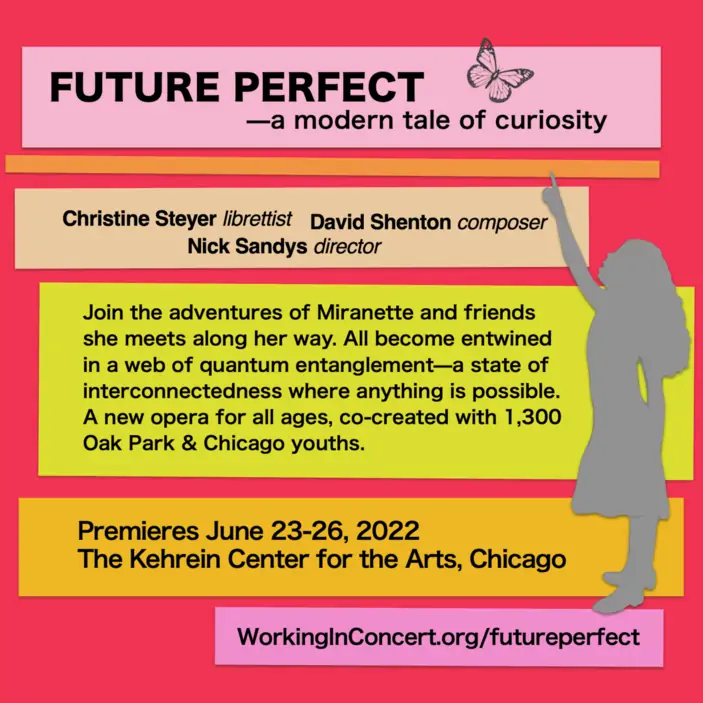
 [rating=3]“Future Perfect—a modern tale of curiosity” is an original opera and a fantastical adventure combined. Billed as: “The Magic Flute” meets “The Wizard of Oz”, the show, sponsored by Bellissima Opera and Working in Concert, is having its premier performance this weekend at The Kehrein Center for the Arts, in Chicago’s Austin neighborhood. Its creation brought together 1,300 Oak Park and Chicago youths and their adult mentors. Together they co-created the libretto through workshops that “examined themes of separateness, interconnectedness, and transcendence.” The basis of the show is “quantum entanglement”, namely, that life is a miracle and that the mystery of the universe is that we are here in the first place, all together as human beings, sharing the same space.
[rating=3]“Future Perfect—a modern tale of curiosity” is an original opera and a fantastical adventure combined. Billed as: “The Magic Flute” meets “The Wizard of Oz”, the show, sponsored by Bellissima Opera and Working in Concert, is having its premier performance this weekend at The Kehrein Center for the Arts, in Chicago’s Austin neighborhood. Its creation brought together 1,300 Oak Park and Chicago youths and their adult mentors. Together they co-created the libretto through workshops that “examined themes of separateness, interconnectedness, and transcendence.” The basis of the show is “quantum entanglement”, namely, that life is a miracle and that the mystery of the universe is that we are here in the first place, all together as human beings, sharing the same space.
The story is centered on a young girl named Miranette, who feels that she doesn’t fit in. She lives in a community called Properburo, where everybody wears gray, black, or dull-colored clothing—and city life is largely behind gates and fences, and the sky is always gray. Miranette doesn’t like the way she is treated at school or at social activities with her friends. Considering that she is much too different from her peers, she is either excluded or excludes herself. She also suffers from, what appears to be, a disability of speech. Despite the fact that Miranette is bright and intellectually curious, other people think she’s stupid because she doesn’t talk, and thus she feels bad about herself. Although it’s not clear whether not talking has preceded being ostracized—or whether she was ostracized and thus has no reason to speak—it doesn’t matter either way. The schoolchildren all wear sashes, and if they don’t follow orders to the letter, they don’t get pins to wear on their sashes. What happens is that in an act of defiance and frustration, Miranette tears off the pins from her sash and removes it. And only then does she leave home and embark on her journey to discover the world at large, where creativity and innovation replace the humdrum of life. By means of a series of illuminating treks through fantasyland, Miranette is enmeshed with different colors, forms, and shapes and new ways of thinking about the world and her place in it. Miranette’s creativity expands when strange animals and unusual people come into play in all sorts of unusual circumstances, where she is loved and wanted. Once her life improves from the dreary place that she grew up in (spoiler alert), she finally talks! The first time it’s because she’s upset about two knights fighting each other and she shouts at them to stop. By speaking out, she has empowered herself to create an environment that is an improvement on the one she finds herself in. Later when she speaks, it is because she is finally content with her new environment as she lives it.
As we watch Miranette undertake her inner and outward journey, we note that the show is structured as a series of imaginative, often comedic, scenes that progress from one to the next. That said, some segments are more amusing and meaningful than others. One of my favorites is about 55 minutes into the show and has to do with flutterbys (i.e., butterflies) emerging from a chrysalis and subsequently dancing; this is immediately followed by a draglion (not a dragon, not a lion) singing a funny operatic song where the key verses end in “LBAO!” All throughout, we note that some lyrics are funny, others serious, some enticing, and others—well, they are just there! The (adult) operatic singers consist of Bellisma Opera’s artistic director Christine Steyer, as well as Wydetta Carter, Hailey Cohen, Dominique Frigo, Jeffrey Goldberg, Rose Guccione, Sarh Kropski, Susan Lewis Friedman, Kaleb Nuesse, Brian Allen Pemer Jr., Carl Ratner, Katie Rub, Peter Stigdon, and Suzanne Walsh, with ensemble members Xandra Daigle, Paul Geiger, Marcela Ossa, Christina Ray, and Barbara Smith.
The presentation is nicely directed by Nick Sandys, who also is the fight choreographer. Speaking of choreography, Cathy Dunn, the assistant director, does a great job with the various dance numbers that pepper the performance. But the genius of the show is the marvelous score by David Shenton that holds disparate parts of the story together. I loved the music in its various dimensions, orchestrations, and blends. The melodies are enticing, and the harmonies are taken nicely from the way that operas are built. Shenton also plays piano as part of the splendidly designed pit orchestra, conducted by Tim Pahel, who doubles as chorus master. Other members of the orchestra include Eli Chen (violin), Emma Strohbusch (viola), Brian Hoffman (cello), Emma Hospelhorn (flute/piccolo), Dan Williams (clarinet/saxophone), and Bobby Everson (percussion). The music itself is worth its weight in gold. The projection design by Reese Craig is especially notable as it enhances the storyline nicely.
It is wonderful to see a show where children have taken on such major roles in its production and have worked side-by-side with adults. One of the reasons that this is an article and not a review is that it would not be fair to critique a production where the libretto and the dialogue were written in part by young people, not to mention that they created some portion of the scenes and costumes, and therefore these lack a “professional touch.” There is also a lot of variation in the actors’ and singers’ performances. That being said, kudos must go to Tekla Schreiner-Witte, who plays Miranette and who holds together an entire show that lasts two hours with no intermission. (Incidentally, I give a lot of credit to the three-year-old child who sat two rows ahead of me and was transfixed by the whole thing.) Other youth in the cast include Isabella Airato, Sam Combs, Benjamin Govertsen, Amelia Holly, Shiloh Jennings, Michael Jones, Caleb Reed-Jennings, Henry Lombardo, Norah Lougachi, Ruby O’Shaugnessey, Lena Thomas, and Jonathan Wilson.
One problem, however, has to do with Miranette’s costume change near the end. In my opinion, she should have never changed from her everyday clothing into a white costume that looks like a combination angel and dragonfly. Instead, she should have transitioned into some type of multicolored garment right after the songs having to do with the various emotions involved with the colors blue, purple, yellow, and red. By having Miranette put on the white and fall asleep and then have the ensemble sing the song about “Transcendence”, it’s as if the only way for the future to be perfect is for an individual to die and go to heaven (because, after all, heaven is supposed to be perfect). I doubt that the creators of the show intended to make this argument! Thus if there is to be an angel leading the way, it ought to be someone who helps out Miranette and guides her to become her best self.
“Future Perfect” was a project that took eight years to develop. This very ambitious show emphasizes racial and ethnic diversity and embraces the possibility of a better, more harmonious world for all of humanity. In short, the performance is more impressionistic than anything else. It’s sad, funny, and real at the same time. The secret to watching it is not to be overly analytical and instead to focus on the lightheartedness of the children’s roles. Although fifteen or twenty minutes could easily be cut from the running time, the production is a pleasant one, especially if you enjoy watching children who are not professional actors take the stage.
The premier of “Future Perfect” is currently at The Kehrein Center for the Arts, 5628 W. Washington Blvd., in Chicago.
There are only four performances: shows are at 7:30 p.m. on Thursday through Saturday- Sunday 4 p.m., June 23-26, 2022.
The show is in English with open captioning.
Tickets are between $5 and $50 each and are available through Working in Concert – Future Perfect. Go to: https://workinginconcert.org/futureperfect/?d=bo
Note that The Kehrein Center for the Arts is a beautiful facility for opera, music, theatre, dance, and the spoken word. Part of the Austin renewal project, it officially opened in May 2019. Neighborhood parking is ample, and the center is walking distance from the green line






Today’s show/Sunday is at 4 pm